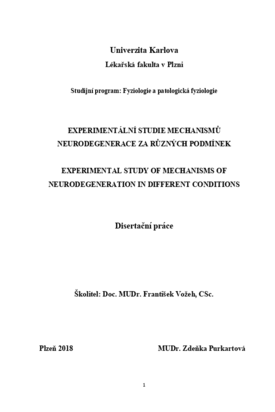Experimentální studie mechanismů neurodegenerace za různých podmínek
Experimental Study of Mechanisms of Neurodegeneration in Different Conditions
dizertační práce (OBHÁJENO)

Zobrazit/
Trvalý odkaz
http://hdl.handle.net/20.500.11956/105918Identifikátory
SIS: 139256
Kolekce
- Kvalifikační práce [336]
Autor
Vedoucí práce
Oponent práce
Pokorný, Jaroslav
Mareš, Jan
Fakulta / součást
Lékařská fakulta v Plzni
Obor
-
Katedra / ústav / klinika
Ústav patologické fyziologie
Datum obhajoby
11. 4. 2019
Nakladatel
Univerzita Karlova, Lékařská fakulta v PlzniJazyk
Čeština
Známka
Prospěl/a
EXPERIMENTÁLNÍ STUDIE MECHANISMŮ NEURODEGENERACE ZA RŮZNÝCH PODMÍNEK - SOUHRN MUDr. Zdeňka Purkartová Mozeček je významná struktura uplatňující se v koordinaci pohybů a v řadě dalších funkcí včetně procesů kognitivních a emočních. K závažným onemocněním mozečku patří velká skupina mozečkových hereditárních degenerací s různým typem dědičnosti, odlišnou patogenezí a pestrými fenotypovými projevy. K výzkumu těchto onemocnění i možností jejich léčby lze využít mnoho typů myších modelů. Jedná se o myši trpící spontánní mutací či myši geneticky modifikované. Cílem naší práce byloanalyzovat dynamiku morfologických změn během mozečkové degenerace u myší typu Lurcher za použití dvojitého fluorescenčního barvení. Dále jsme se věnovali transplantaci embryonální mozečkové tkáně ve formě suspenze u dospělých myší typu Lurcher kmene B6CBA, myší pcd kmene B6.BR a myší typu wild obou těchto kmenů s dvouměsíčním přežíváním příjemců po operaci a transplantaci identické suspenze u dospělých myší typu Lurcher kmenů B6CBA a C3H a myší typu wild obou těchto kmenů se šestiměsíčním přežíváním příjemců po operaci. Prokázali jsme tyto hlavní charakteristiky degenerujících Purkyňových buněk u mutantů Lurcher: narušenou kontinuitu řady Purkyňových buněk, přítomnost tmavých skvrn v buněčných jádrech, fragmentaci jadérek a nerovnoměrné...
EXPERIMENTAL STUDY OF MECHANISMS OF NEURODEGENERATION IN DIFFERENT CONDITIONS - SUMMARY MUDr. Zdeňka Purkartová The cerebellum is an important structure involved in motor coordination and many other functions including cognitive and emotional processes. Severe cerebellar diseases include a wide group of cerebellar hereditary degenerations with different types of heredity, different pathogenesis and diverse phenotypic manifestation. Many types of mouse models can be used to investigate these diseases and their therapy. These mice carry spontaneous mutations or are genetically modified. The aim of this work was to analyse the dynamics of morphological changes of cerebellar degeneration in Lurcher mice using fluorescent double staining. We also performed transplantation of embryonic cerebellar tissue suspension in adult Lurcher B6CBA mice, B6.BR mice and wild-type mice of both strains with two-month survival after surgery and transplantation of identical suspension in adult Lurcher B6CBA mice and C3H mice and wild- type mice of both these strains with six-month survival after surgery. We have confirmed these main characteristics of the degenerating Purkinje cells in Lurcher mutants: the disrupted continuity of the Purkinje cell layer, the presence of dark spots in the cell nuclei, the fragmentation of nuclei...
